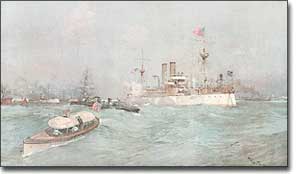44c. "Remember the Maine!"

There was more than one way to acquire more land. If the globe had already been claimed by imperial powers, the United States could always seize lands held by others. Americans were feeling proud of their growing industrial and military prowess. The long-dormant Monroe Doctrine could finally be enforced. Good sense suggested that when treading on the toes of empires, America should start small. In 1898, Spain was weak and Americans knew it. Soon the opportunity to strike arose.
Involvement in Cuba

Cuba became the nexus of Spanish-American tensions. Since 1895, Cubans had been in open revolt against Spanish rule. The following year, Spain sent General Valeriano Weyler to Cuba to sedate the rebels. Anyone suspected of supporting independence was removed from the general population and sent to concentration camps. Although few were summarily executed, conditions at the camps led over 200,000 to die of disease and malnutrition. The news reached the American mainland through the newspapers of the yellow journalists. William Randolph Hearst and Joseph Pulitzer were the two most prominent publishers who were willing to use sensational headlines to sell papers. Hearst even sent the renowned painter Frederick Remington to Cuba to depict Spanish misdeeds. The American public was appalled.
The Maine Sinks
In February 1898, relations between the United States and Spain deteriorated further. Dupuy de Lôme, the Spanish minister to the United States had written a stinging letter about President McKinley to a personal friend. The letter was stolen and soon found itself on the desk of Hearst, who promptly published it on February 9. After public outcry, de Lôme was recalled to Spain and the Spanish government apologized. The peace was short-lived, however. On the evening of February 15, a sudden and shocking explosion tore a hole in the hull of the American battleship Maine, which had been on patrol in Havana harbor. The immediate assumption was that the sinking of the Maine and the concomitant deaths of 260 sailors was the result of Spanish treachery. Although no conclusive results have ever been proven, many Americans had already made up their minds, demanding an immediate declaration of war.
McKinley proceeded with prudence at first. When the Spanish government agreed to an armistice in Cuba and an end to concentration camps, it seemed as though a compromise was in reach. But the American public, agitated by the yellow press and American imperialists, demanded firm action. "Remember the Maine, to hell with Spain!" was the cry. On April 11, 1898, McKinley asked the Congress for permission to use force in Cuba. To send a message to the rest of the world that the United States was interested in Cuban independence instead of American colonization, Congress passed the Teller Amendment, which promised that America would not annex the precious islands. After that conscience-clearing measure, American leaders threw caution to the wind and declared open warfare on the Spanish throne.






